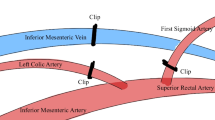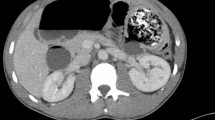Abstract
The retention of foreign bodies after surgery is rare, but carries significant morbidity and mortality as well as financial and legal implications. Such retained items cause a foreign-body reaction, which in the case of cotton-based materials are called gossypibomas. We present the case of an 84-year-old woman with a pseudotumor secondary to a retained dressing gauze roll, presenting 5 months after resection of a gluteal sarcoma, which had raised concerns of local recurrence. We also outline the imaging modalities that may assist in diagnosis of a retained foreign body, and suggest the MRI “row of dots” sign as a useful radiological feature associated with gossypiboma. Awareness of the imaging appearances of retained foreign bodies allows the inclusion of this possibility in differential diagnosis of a mass in patients with a surgical history.

Similar content being viewed by others
References
Gawande AA, Studdert DM, Orav EJ, Brennan TA, Zinner MJ. Risk factors for retained instruments and sponges after surgery. N Engl J Med. 2003;348(3):229–35.
Manzella A, Filho PB, Albuquerque E, Farias F, Kaercher J. Imaging of gossypibomas: pictorial review. AJR Am J Roentgenol. 2009;193(6 Suppl):S94–101.
Dux M, Ganten M, Lubienski A, Grenacher L. Retained surgical sponge with migration into the duodenum and persistent duodenal fistula. Eur Radiol. 2002;12 Suppl 3:S74–7.
Nakajo M, Jinnouchi S, Tateno R. 18 F-FDG PET/CT findings of a right subphrenic foreign-body granuloma. Ann Nucl Med. 2006;20(8):553–6.
Kernagis LY, Siegelman ES, Torigian DA. Case 145: retained sponge. Radiology. 2009;251(2):608–11.
Lo CP, Hsu CC, Chang TH. Gossypiboma of the leg: MR imaging characteristics. A case report. Korean J Radiol. 2003;4(3):191–3.
Garner HW, Kransdorf MJ, Bancroft LW, Peterson JJ, Berquist TH, Murphey MD. Benign and malignant soft-tissue tumors: post-treatment MR imaging. Radiographics. 2009;29(1):119–34.
Kransdorf MJ, Murphey MD. Imaging of Soft Tissue Tumours. 2nd ed. Philadelphia: Lippincott Williams & Wilkins; 2006.
Kransdorf MJ, Murphey MD. Soft tissue tumors: post-treatment imaging. Radiol Clin North Am. 2006;44(3):463–72.
Conflicts of interest
The authors declare that there are no potential conflicts of interest.
Author information
Authors and Affiliations
Corresponding author
Rights and permissions
About this article
Cite this article
Shiraev, T., Bonar, S.F., Stalley, P. et al. MRI “row of dots sign” in gossypiboma: an enlarging mass 8 months after sarcoma resection. Skeletal Radiol 42, 1017–1019 (2013). https://doi.org/10.1007/s00256-013-1596-5
Received:
Revised:
Accepted:
Published:
Issue Date:
DOI: https://doi.org/10.1007/s00256-013-1596-5




